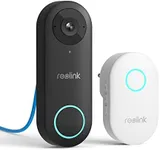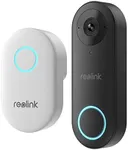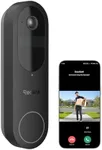Buying Guide for the Best Video Doorbell Intercoms
Choosing the right video doorbell intercom can significantly enhance your home security and convenience. When selecting a video doorbell intercom, it's important to consider various features and specifications to ensure it meets your specific needs. Here are some key specs to look out for and how to navigate them.Video ResolutionVideo resolution refers to the clarity and detail of the video captured by the doorbell camera. Higher resolution means clearer and more detailed images. Common resolutions include 720p, 1080p, and 4K. If you want to clearly identify faces and details, go for at least 1080p. For general monitoring, 720p might suffice. Choose based on how clear you need the footage to be.
Field of ViewField of view (FOV) is the extent of the observable area the camera can capture. A wider FOV means the camera can see more of the area in front of your door. Typical FOV ranges from 90 degrees to 180 degrees. If you have a wide porch or want to see more of your front yard, opt for a wider FOV. For smaller areas, a narrower FOV might be adequate.
Two-Way AudioTwo-way audio allows you to communicate with visitors through the doorbell. This feature is important for interacting with delivery personnel, guests, or even deterring potential intruders. Ensure the audio quality is clear and check if there is any lag. If you frequently interact with visitors, this feature is essential.
Night VisionNight vision enables the camera to capture clear video in low-light or dark conditions. This is crucial for monitoring your doorstep at night. Look for infrared (IR) night vision or color night vision. If you need to monitor your entrance 24/7, ensure the doorbell has good night vision capabilities.
Motion DetectionMotion detection alerts you when movement is detected near your door. This feature is important for security as it can notify you of any activity. Some models offer adjustable sensitivity and zones. If you want to avoid false alarms from passing cars or animals, look for customizable motion detection settings.
Storage OptionsStorage options refer to how the video footage is saved. Common options include cloud storage and local storage (SD card). Cloud storage often requires a subscription but offers remote access and more storage space. Local storage is a one-time cost but may have limited capacity. Choose based on your preference for accessibility and budget.
Power SourceVideo doorbells can be powered by batteries, hardwiring, or both. Battery-powered models are easier to install but require regular recharging. Hardwired models are more reliable but need existing doorbell wiring. If you prefer a hassle-free setup, go for battery-powered. For a more permanent solution, choose hardwired.
Smart Home IntegrationSmart home integration allows the doorbell to connect with other smart devices like smart locks, lights, and voice assistants. This can enhance your home automation and security. Check compatibility with your existing smart home ecosystem. If you have or plan to have a smart home setup, this feature is beneficial.
Weather ResistanceWeather resistance ensures the doorbell can withstand various weather conditions like rain, snow, and extreme temperatures. Look for an IP rating (e.g., IP65) which indicates the level of protection. If you live in an area with harsh weather, ensure the doorbell is weather-resistant to avoid damage.



















